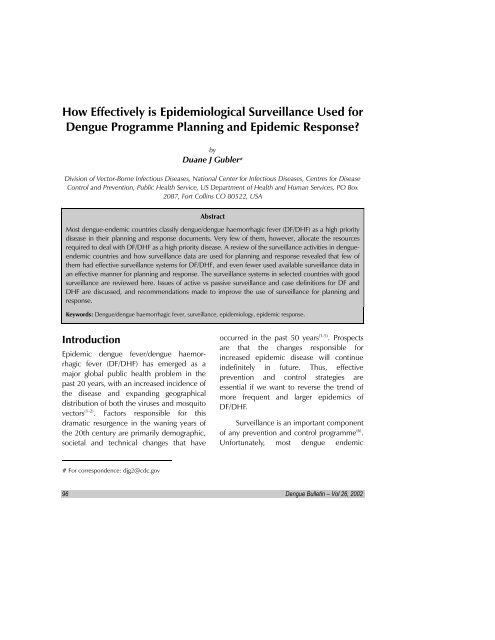Dengue Bulletin
Dengue Bulletin
Dengue Bulletin
- TAGS
- dengue
- bulletin
- 203.90.70.117
Create successful ePaper yourself
Turn your PDF publications into a flip-book with our unique Google optimized e-Paper software.
How Effectively is Epidemiological Surveillance Used for<br />
<strong>Dengue</strong> Programme Planning and Epidemic Response?<br />
by<br />
Duane J Gubler #<br />
Division of Vector-Borne Infectious Diseases, National Center for Infectious Diseases, Centres for Disease<br />
Control and Prevention, Public Health Service, US Department of Health and Human Services, PO Box<br />
2087, Fort Collins CO 80522, USA<br />
Abstract<br />
Most dengue-endemic countries classify dengue/dengue haemorrhagic fever (DF/DHF) as a high priority<br />
disease in their planning and response documents. Very few of them, however, allocate the resources<br />
required to deal with DF/DHF as a high priority disease. A review of the surveillance activities in dengueendemic<br />
countries and how surveillance data are used for planning and response revealed that few of<br />
them had effective surveillance systems for DF/DHF, and even fewer used available surveillance data in<br />
an effective manner for planning and response. The surveillance systems in selected countries with good<br />
surveillance are reviewed here. Issues of active vs passive surveillance and case definitions for DF and<br />
DHF are discussed, and recommendations made to improve the use of surveillance for planning and<br />
response.<br />
Keywords: <strong>Dengue</strong>/dengue haemorrhagic fever, surveillance, epidemiology, epidemic response.<br />
Introduction<br />
Epidemic dengue fever/dengue haemorrhagic<br />
fever (DF/DHF) has emerged as a<br />
major global public health problem in the<br />
past 20 years, with an increased incidence of<br />
the disease and expanding geographical<br />
distribution of both the viruses and mosquito<br />
vectors (1-2) . Factors responsible for this<br />
dramatic resurgence in the waning years of<br />
the 20th century are primarily demographic,<br />
societal and technical changes that have<br />
# For correspondence: djg2@cdc.gov<br />
occurred in the past 50 years (1-5) . Prospects<br />
are that the changes responsible for<br />
increased epidemic disease will continue<br />
indefinitely in future. Thus, effective<br />
prevention and control strategies are<br />
essential if we want to reverse the trend of<br />
more frequent and larger epidemics of<br />
DF/DHF.<br />
Surveillance is an important component<br />
of any prevention and control programme (6) .<br />
Unfortunately, most dengue endemic<br />
96 <strong>Dengue</strong> <strong>Bulletin</strong> – Vol 26, 2002









